Debris flow disaster is one of the most serious disasters in China's geological disasters, which seriously threatens people's lives and property and restricts the sustainable development of China's economy and society [1]. In the past, the monitoring methods of debris flow were generally to establish preliminary simple monitoring points in the field environment, mainly to record the specific situation occurred on the site by artificial means, the technical content is low, the accuracy of early warning and forecasting is not high, and it is susceptible to environmental conditions. Monitoring and early warning work is extremely difficult to carry out in the event of a storm. Therefore, this paper uses the microprocessor STM32F107VCT6 and the low-noise dual-channel analog-to-digital converter chip AD7706 to jointly construct a low-power debris flow remote monitoring system, which realizes uninterrupted real-time data acquisition for the debris monitoring site multi-monitoring parameters, effectively improving data acquisition speed and acquisition accuracy. Reduce system power consumption, greatly improve the stability of debris flow remote monitoring system, and facilitate remote dynamic real-time monitoring of debris flow in harsh outdoor environments [2].
1 system overall structural designThe monitoring system is mainly composed of low-power microprocessor STM32F107VCT6, power module, data acquisition module (mud position and flow rate acquisition module), A/D conversion module, data storage module, data transmission module and geological disaster monitoring and warning cloud server. STM32F107VCT6 is used as the main central processing unit to control and coordinate specific data acquisition, storage, transmission and command control; A/D conversion circuit can collect mud level and flow rate monitoring data; and effectively transmit monitoring data to GPRS/Beidou satellite multi-mode communication mode. Geological disaster monitoring and early warning cloud server; cloud server can query on-site monitoring data in real time, can perform corresponding data analysis and early warning model according to historical data, and judge the trend of debris flow movement to issue early warning and forecast signals in time; data storage module is responsible for saving collected data in real time to SD card [3]. The overall structure of the system is shown in Figure 1.
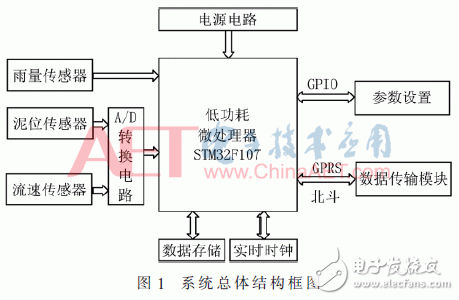
The STM32F107VCT6 is an ARM Cortex-M3 core. It is a low-cost, high-performance RISC microprocessor that integrates a variety of high-performance industrial interconnected standard interfaces, including 10 timers, AD analog-to-digital conversion, DA digital-to-analog conversion, and wireless. Network interface, external 2 Kbit IIC interface and SPI mode MicroSD storage interface; 6 to 12 clock cycles for fast nested interrupts, MPU protection setting access rules, and software with perfect compatibility, can adapt A variety of applications.
2.2 data acquisition circuit The STM32F107VCT6 timer interrupt is used to collect the on-site rainfall. The electromagnetic wave radar is used to collect the debris flow data. The Doppler radar is used to collect the debris flow velocity data, and the voltage signals output from the mud and flow sensors are input to the AD conversion circuit for analog-to-digital conversion. . The AD conversion chip used in the system is the AD7706. The AD7706 is a high performance, 16-bit sigma-delta analog-to-digital converter with high resolution and low power consumption to meet wide dynamic range and low anti-aliasing requirements. The AD7706 features a three-channel quasi-differential analog input that simplifies hardware circuit design, supports unipolar, bipolar signal input and self-calibration, and system calibration. It has a nonlinearity of 0.003% and operates at 3.3 V and 5 V. Power mode. This system uses the same 3.3 V power supply mode as the microprocessor. The AD7706 communicates with the microcontroller via SPI.  Serial clock input SCLK, serial data input DIN, serial data output DOUT, status signal
Serial clock input SCLK, serial data input DIN, serial data output DOUT, status signal  They are connected to PA4, PA5, PA6, PA7 and PA8 of STM32F107VCT6 [4]. Its interface circuit is shown in Figure 2.
They are connected to PA4, PA5, PA6, PA7 and PA8 of STM32F107VCT6 [4]. Its interface circuit is shown in Figure 2.
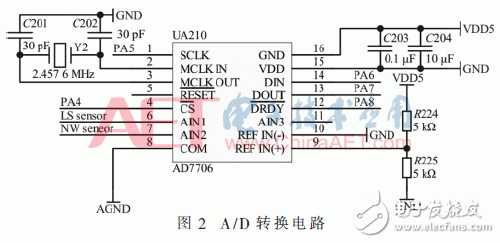
Most of the debris flow remote monitoring systems work in the wild environment and need to provide a reliable and stable power supply for the system. The system's power supply circuit is available in 12 V, 5 V, and 3.3 V. The 12 V power supply consists of a solar power supply system, which mainly includes monocrystalline silicon solar panels and lithium batteries, used for mud level sensors, flow rate sensors, and data transmission modules. Power is supplied; the LP3878 power module provides a stable 5 V output for powering the data acquisition circuitry [5]. The schematic diagram of the 5 V power supply circuit is shown in Figure 3.
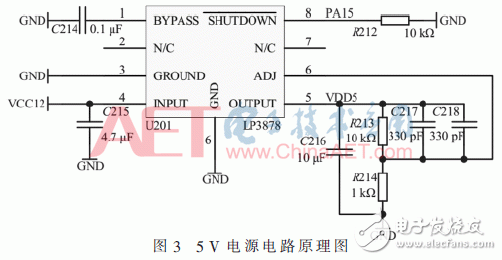
The power supply of the microprocessor is 3.3 V, and the 12 V power supply from the battery is converted to 3.3 V by the step-down circuit. Considering the low power consumption design of the system, the 3.3 V power supply circuit uses the LTC3631, a very low power consumption module, and the power supply circuit. The schematic is shown in Figure 4. The LTC3631 has a quiescent current of 12 μA and a maximum output current of 100 mA at 3.3 V.

The MicroSD card is a Flash multi-function micro memory card with low mobility and low power consumption. It has intelligent protection function and features fast transmission efficiency and high storage capacity. The data storage circuit is used to store the collected monitoring data in the real-time to the MicroSD card, so as to ensure the integrity of the data and realize the historical query of the data, and the data can be saved when the signal quality is not transmitted. STM32F107VCT6 does not have SDIO interface, and uses SPI communication mode to realize read and write operations on MicroSD card [6]. The MicroSD card interface circuit is shown in Figure 5.
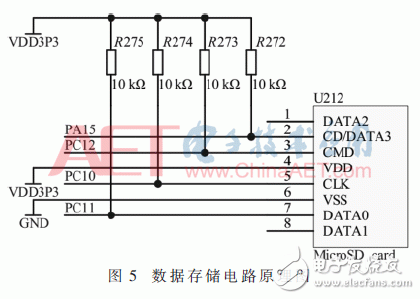
The design data transmission circuit is divided into two parts, namely GPRS transmission and Beidou satellite transmission. As a regular transmission mode, GPRS transmission is simple, reliable and stable, and GPRS transmission is preferred in data transmission. In some remote areas, the Beidou satellite transmission mode should be selected when the GPRS signal cannot be met. The dual transmission mode can effectively ensure the reliability and stability of data transmission. The system is connected to the GPRS module and the Beidou satellite transmission module through the RS232 serial port.
The GPRS module uses Siemens MC52iR3, which has a low power mode. The operating current is only 3 mA in sleep mode. It can support the TCP/IP protocol stack. The monitoring data collected in the field can be collected in real time via TCP/IP data packet through GPRS network. Transfer to remote geological disaster monitoring and warning cloud server. The Beidou satellite transmission module selects the BGT-500 Beidou communication module of Guozhiheng Group. It is compact in structure and supports the S and L frequency points of the RDSS of the Beidou satellite system and the B1 and L1 frequency points of the RNSS. It can realize the bidirectional positioning and shortness of the RDSS. The message communication function has high integration and low power consumption, and transmits monitoring data to the cloud server through Beidou satellite in short message mode.
3 system software designThe system software design is implemented in C language programming under ARM's Keil5 integrated development environment, including system initialization, rainfall collection, debris flow and flow rate acquisition, data storage, and data transmission. The main program flow chart is shown in Figure 6.

The data acquisition program is completed by the microprocessor and AD7706, mainly including AD data acquisition and digital data acquisition. After the system initializes the AD7706 after power-on, configure the microprocessor port, select the AD input channel by writing to the communication register and set the next operation as the write clock register; set the clock register according to the actual needs of the mud position and flow rate sensor and select the appropriate AD update rate. Write the communication register and set the next operation to write the set register; write the set register to select the appropriate parameters and start AD conversion, when the query DRDY changes from high level to low level, the data conversion is completed, then write the communication register and set One operation is to read the data register, and the latest AD conversion data is obtained by reading the data in the data register. The AD data acquisition flow chart is shown in Figure 7.
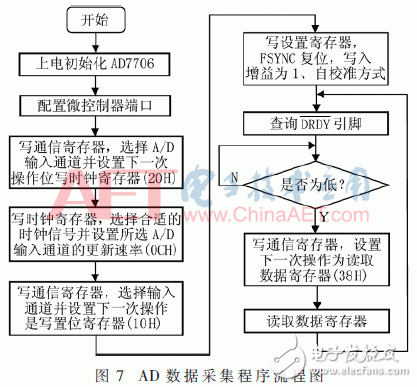
The system uses SPI communication mode for data storage. After the MicroSD card is powered on, it will automatically enter the bus mode. The embedded microprocessor sends 74 clock cycles to the MicroSD card to pull the chip select signal CS signal low. Considering that the MicroSD card read and write commands are not easy to read and write, the FAT32 file system is used to store data in the form of files, and the functions of FAT32_Status, FAT32_Open_File, FAT32_Close_File, FAT32_Read_File are directly called to operate the MicroSD card [7].
3.3 Data Transmission Software DesignThe data transmission software adopts a modular design idea, and the embedded microprocessor and the cloud server exchange data through GPRS or Beidou. The data transmission software mainly includes a system initialization module, a signal detection module, a data establishment connection module, and a data transmission module. After the serial port is initialized, the transfer function is first called to detect the transmission signal. If the GPRS network is detected, the GPRS mode is used for transmission, otherwise the Beidou satellite transmission mode is adopted. The microprocessor establishes a connection with the back-end cloud server, calls the GPRS connection() function, and sends data in the form of TCP/IP data packets according to the requirements of the cloud server; in the Beidou satellite transmission mode, the BDConnction() function is called to detect the Beidou host number. Whether it is consistent with the cloud server Beidou host, if it is the same, it will continue to execute the data transmission program, and in Beidou mode, the data will be sent in short message format [8]. The data transmission software flow chart is shown in Figure 8.

In this paper, the microprocessor STM32F107VCT6 and AD7706 are used together to construct a remote monitoring system for debris flow. The system can collect real-time online debris flow, mud level and flow rate data of debris flow disasters, data transmission through GPRS/Beidou satellite transmission network, remote geological disaster monitoring and early warning cloud server and Geological disaster site can realize real-time online communication, real-time query, analysis and data processing on the field data. The system is stable and reliable, low cost and low power consumption, and has good application prospects in debris flow hazard monitoring.
Polygonal Steel Pole,Polygonal Steel Electric Pole,Polygonal Steel Light Pole
YIXING FUTAO METAL STRUCTURAL UNIT CO.,LTD( YIXING HONGSHENGYUAN ELECTRIC POWER FACILITIES CO.,LTD.) , https://www.chinasteelpole.com